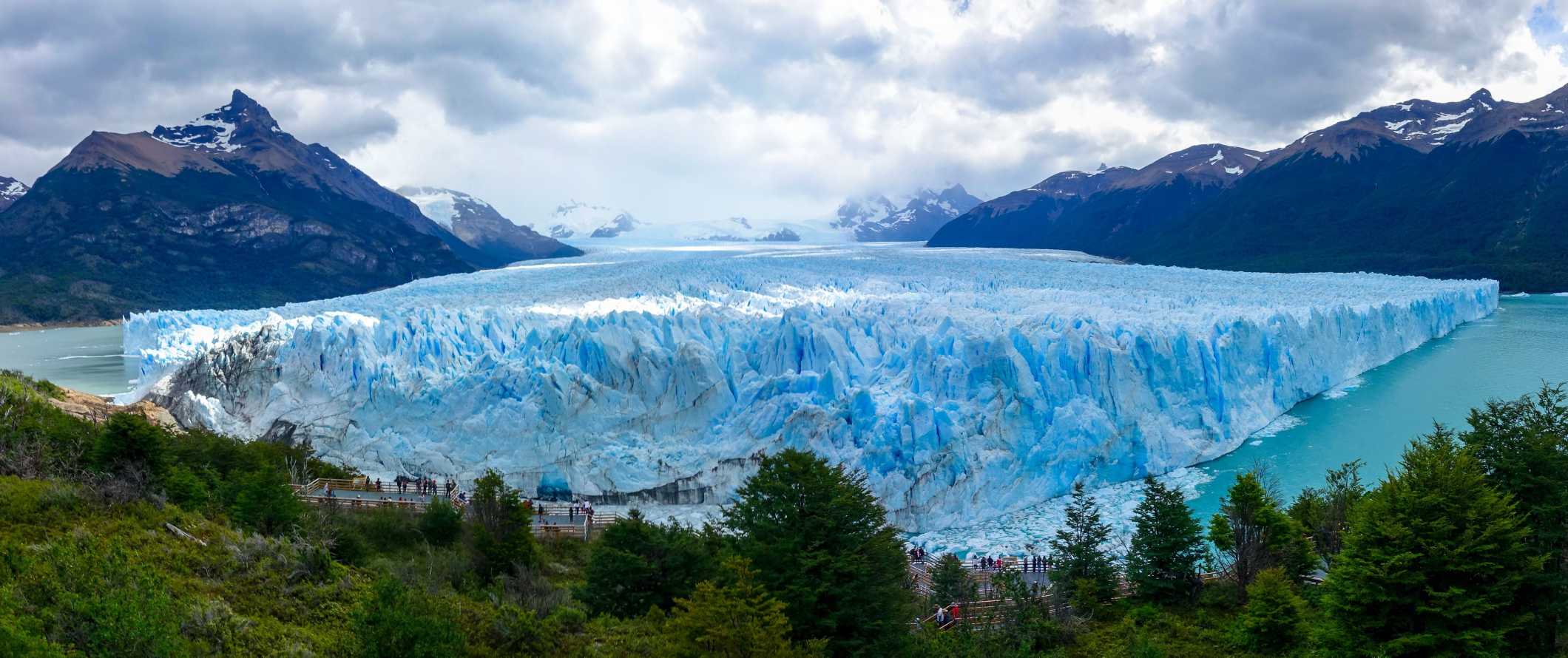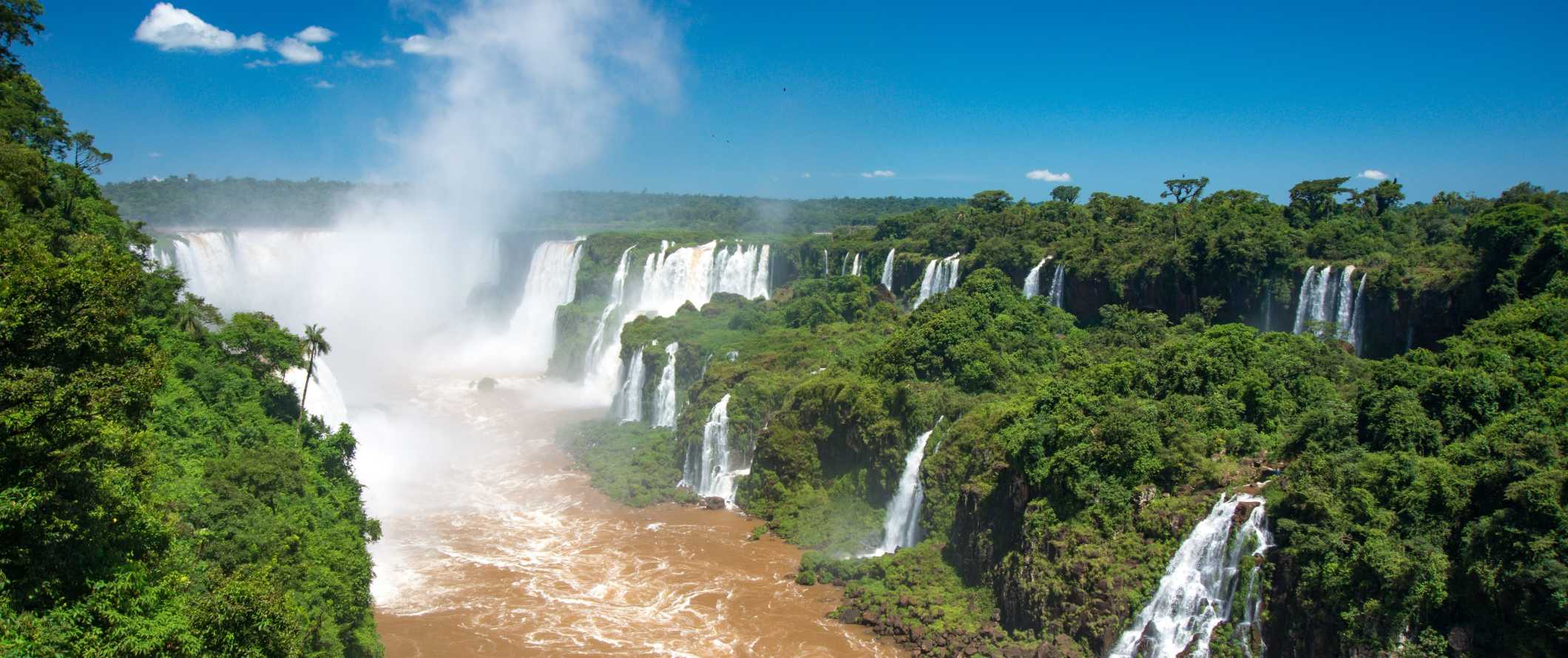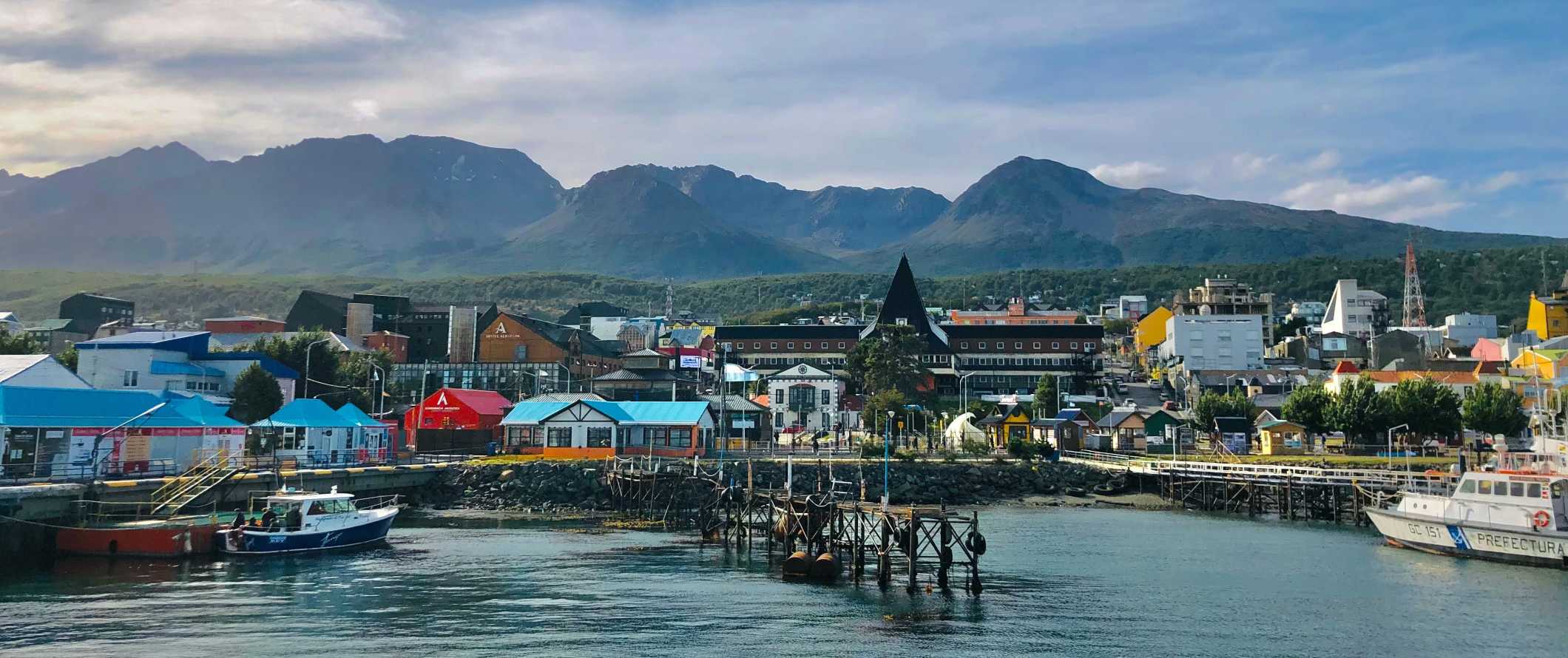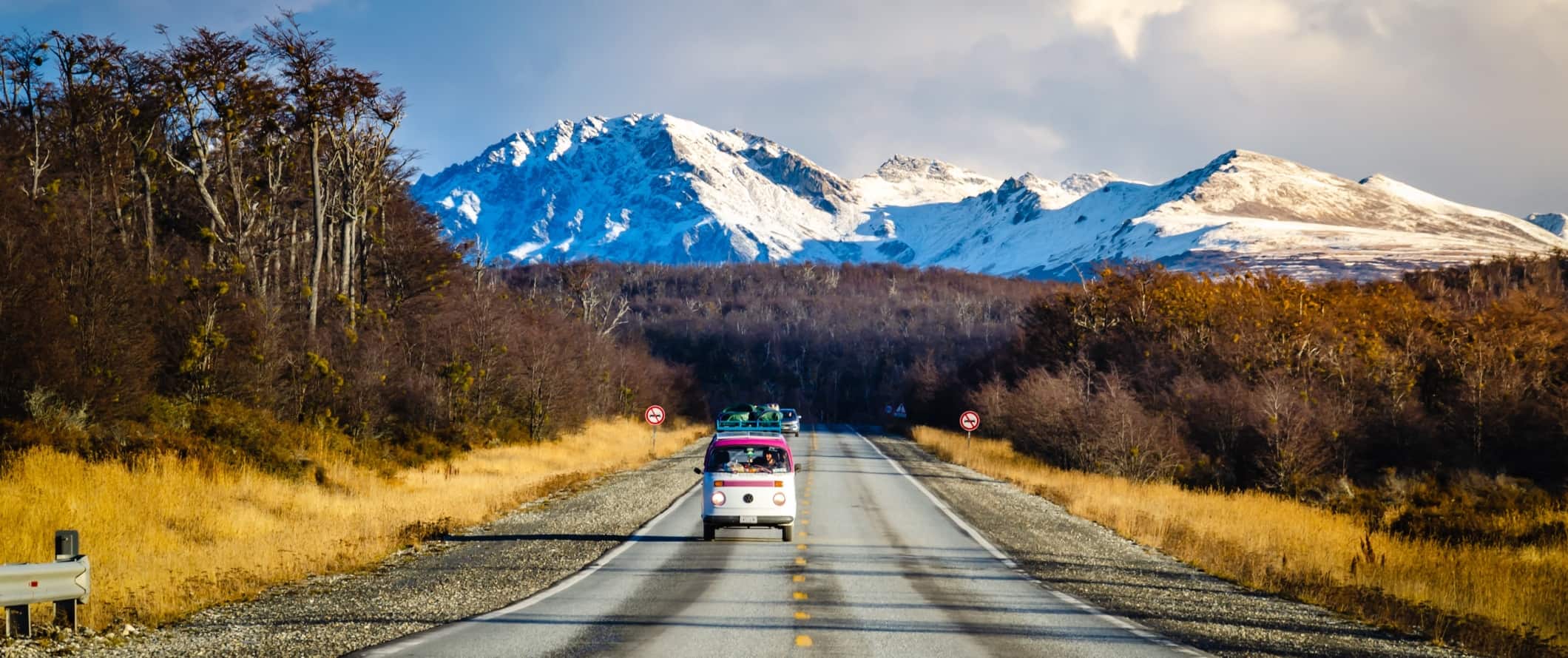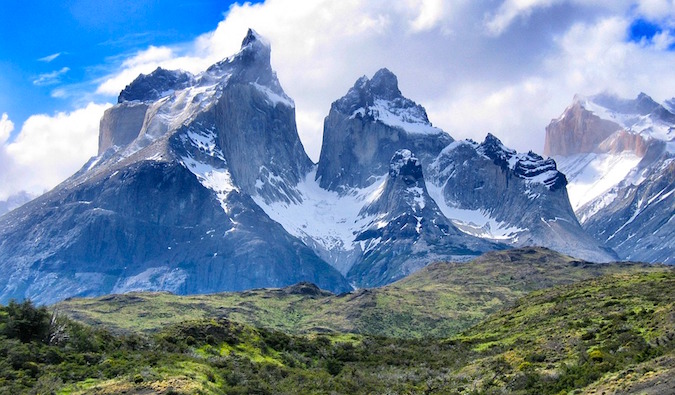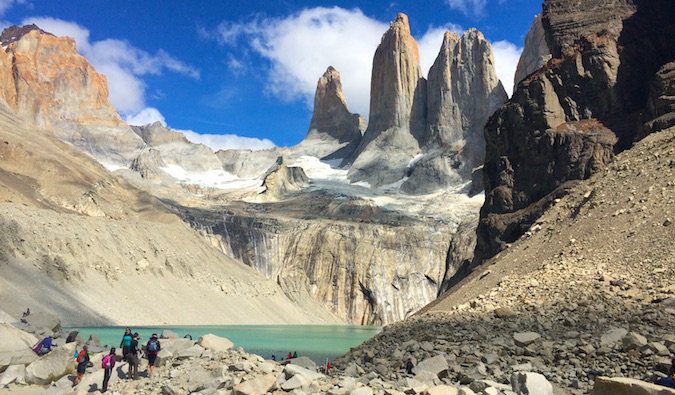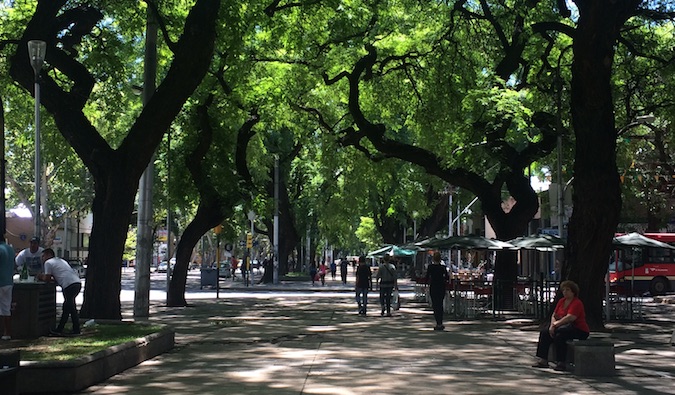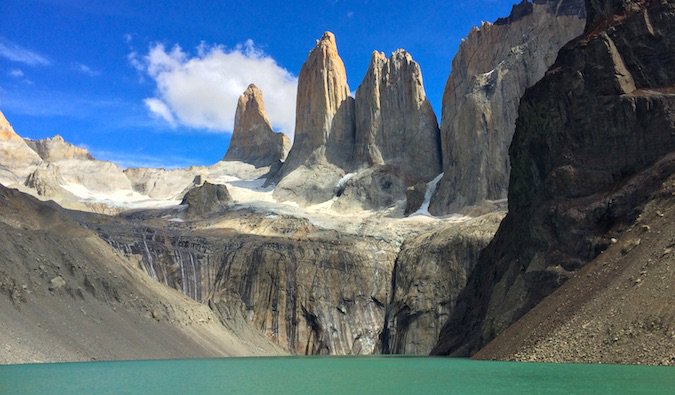Argentina is one of the most popular countries to visit in South America. Whether you’re backpacking the entire country or just visiting on a short holiday looking to drink wine, eat steak, and do some hiking, Argentina will not disappoint you. I love the place to death.
From the relaxed café culture of Buenos Aires to the natural beauty of the massive Iguazu Waterfalls, the stunning Perito Moreno glacier to the charming vineyards of Mendoza, Argentina is a wonderfully beautiful country with world-class landscapes to match the delicious steaks, award-winning wine, and lively and welcoming people you’ll find here.
Argentina blew away all of my expectations.
This travel guide to Argentina can help you plan your trip, stay safe, stay on a budget, and ensure you make the most of your visit here.
Note: Argentina suffers from incredible inflation and prices vary widely and increase without notice. The prices here might be accurate as of the day we publish but could be dramatically different by the time you get there. Keep that in mind as you plan your expenses.
Table of Contents
Click Here for City Guides
Top 5 Things to See and Do in Argentina
1. Enjoy the culture of Buenos Aires
Nicknamed the “Paris of South America,” Buenos Aires is an amazing and fun city with a lot of culture, fantastic nightlife, food, and shopping. Stay in the trendy Palermo neighborhood and walk the tree-lined streets, visit the Museum of Latin American Art in Buenos Aires (aka MALBA), and explore Palermo Soho which has a more youthful vibe and is crammed with cool shops and boutiques.
Additionally, on the southern border of Palermo is La Recoleta Cemetery, one of the most atmospheric graveyards on the planet and home to several famous Argentines, including Eva Peron, several past presidents, patriots, poets, and other VIPs of Argentine history. El Museo Nacional de Bellas Artes, the National Museum of Fine Arts, is nearby as well. Opened in 1895, the museum houses works by Goya, Monet, Rubens, Rembrandt, Van Gogh, and many other masters.
2. Marvel at Iguazu Falls
With 450,000 cubic feet of water thundering down the 275 cascades every second, it’s easy to see why this massive waterfall is so popular. The water plunges below in a powerful and sensational flurry of white water and mist with rainbows stretching above it all. The uneven cascades are also some of the tallest in the world, as they measure between 62-85 meters (210-269 feet). A sturdy wooden walkway allows visitors to wander out to get a closer, face-to-face look at the falling water. Some might remember the falls played a supporting role in the films Indian Jones and the Kingdom of the Crystal Skull, Captain America: Civil War, and The Mission, among many others.
You can find several types of guided trips leaving from Buenos Aires or just go on the local bus yourself. Stay in Argentina and get drenched on a boat ride around the falls or spring for a tour that includes Brazil on the opposite shore. The view from Brazil is arguably better, since you’re on a narrow ridge surrounded by the falls in Argentina. The entry fee for Iguazú Falls National Park on the Argentine side is 20,000 ARS.
3. Wander Salta
Located in the northwest of the country, Salta is a small city with outstanding museums, plaza-side cafes, and a lively folk music tradition. The colonial architecture of the city is well preserved here too. The most popular museum is Museo de Arqueología de Alta Montaña (MAAM), opened in 2004 for the mummies of three children sacrificed by the Inca and discovered in 1999. Don’t miss the Teleférico San Bernardo, a cable car that glides through the air to a hilltop with a gorgeous view of the whole city. A round-trip ticket for San Bernardo is 8,000 ARS.
4. Learn the tango
Argentina is famous for its national dance, the tango. You’re bound to run into it everywhere you go with people quite literally practicing in the streets. Throughout the country there are studios that offer lessons if you want to learn and free public places to watch the locals dance away. In Buenos Aires, splurge on a tango show at the historic Teatro Tabarís or Gala Tango. A more budget option is the outdoor shows in Plaza Dorrego, where the best dancers can be found every Sunday afternoon.
5. Explore Mendoza
Mendoza is famous for its wine (especially its excellent Malbecs), steak, and beautiful landscapes. I spent over a week here biking around wineries, hiking, visiting canyons, and gorging on steak and wine. You can find tons of wine tours to do. Mendoza’s Wine Harvest Festival (“Fiesta de la Vendimia”) is held in February and March every year and has folk dancing, musical performances, fireworks, beauty contests, freely flowing wine, and colorful parades. If you need a break from eating and drinking, try horseback riding at one of the many estancias (large private ranches) in the region. The city is also a great base for lots of outdoor activities in the surrounding mountains. If you have time, head two hours northwest to Uspallata to hike Cerro Siete Colores, the Seven Color Mountain.
Other Things to See and Do in Argentina
1. Take the train to the clouds
Sure, it’s a train built for tourists and super overpriced, but taking this train through the clouds and lush forest is so breathtaking I don’t mind. This is a 400-kilometer (250-mile), 16-hour round trip into the Andes from the town of San Antonio de los Cobres. You can buy the train ticket with the bus ride between Salta and San Antonio de los Cobres included, or via just the train. Consider buying just the train ticket so you can spend a little time checking out the Andean culture (and llamas) in San Antonio. As the train climbs to 4,200 meters (13,779 feet), you’ll be rewarded with spectacular views overlooking mountains, forests, and valleys. It only operates seasonally and on specific days of the week, so be sure to check the schedule before you go. The website only shows prices once you pick a date for the reservation.
2. Climb Cerro Aconcagua
At almost 7,000 meters tall (23,000 feet), Cerro Aconcagua is not only the country’s highest mountain but also the highest in the Western Hemisphere. This climb isn’t for the faint-hearted as it’s estimated to take a couple of weeks to acclimatize to the altitude and reach the summit. However, it’s a challenging hike, not a technical climb. Many hikers set their sights on part of the mountain, without risking the dangers of oxygen deprivation near the summit. If you love a challenge and are a practiced hiker, it’s an adventure worth considering! Due to the instability of the peso, many trekking companies post prices in USD. Guided summit hikes cost around $5,000 USD while an 8-day trek around the mountain (not to the summit but around the various camps) costs around $2,000 USD. The most popular option is a 4-day hike around the mountain, which costs $700 USD per person. Not into hiking? Nearby Los Horcones Lake is only 2,900 meters (9,514 feet) above sea level and a popular fishing destination.
3. Explore Valle de la Luna
Translated as “Valley of the Moon,” this dramatic landscape dates to the Triassic period. Winds and rain have carved the rocks into strange formations that give this place the look of a lunar landscape. Despite the arid conditions, the area is great for wildlife spotting as it’s home to foxes, owls, armadillos, condors, and guanacos. A wild cousin of the llama, guanacos will give your landscape photos a decidedly South American flair. The unique geological formations and fossil beds have earned its status as a UNESCO World Heritage Site. Don’t miss the Museo de Sitio William Sill, built over impressive dinosaur fossils where you can watch archeologists at work.
The best way to explore the park is via a rental car. Once you have that, you can take the 25-mile circuit tour, stopping at five different points along the way, each one offering stunning sights and views of the park. The circuit should take approximately three hours. There are also hikes through the park. One of the most popular is the trek up to Cerro Morado, the tallest mountain in the park at nearly 1,900 meters (6,000 feet). The walk takes about three hours and, once at the top, offers wow-inducing views of the natural landscape below. Admission to the park is 5,000 ARS.
4. Hike on Perito Moreno Glacier
Located within the expansive Los Glaciares National Park is the impressive Perito Moreno glacier. At almost 4,570 meters (15,000 feet) wide and 61 meters (200 feet) tall, it’s one of the coolest sights I’ve ever seen. You can hike on the glacier (which is an epic experience) or walk on the metal platforms constructed a stone’s throw from the massive wall of ice. You’ll need a licensed guide, ropes, and crampons to hike on the glacier but you can take the bus from El Calafate and do the platform walk on your own. Boat rides to Perito Moreno get you even closer and can include other nearby glaciers like Spegazzini and Upsala. Depending on the season, a full-day tour including a boat ride costs around 99,000 ARS. Austral summer, from December to February, has higher prices.
5. Day trip to San Rafael
Located a few hours from Mendoza, this tiny little town is a wonderful place to see wineries. Try the local Malbecs and other reds that go perfectly with an Argentine asado. Like Mendoza, this is a great place to go on a bike ride through the picturesque vineyards. Don’t miss out on the nearby stunning Atuel Canyon, where you can go whitewater rafting in the summer. San Rafael is a charming little place to relax and slow down to enjoy the local pace of life. A bus from Mendoza to San Rafael costs 2,500 ARS for a one-way ticket.
6. Visit Ushuaia
Ushuaia is the most southerly city in the world and the largest city in Tierra del Fuego. This is a very popular town for travelers coming to the end of their South American journey, or for those traveling to Antarctica. This is the launch point for all Antarctica cruises, as the continent is only 1,100 kilometers (680 miles) away. Plan at least three days here to go hiking in the national park, walk among the penguins on Hammer Island, and try one of the local tea houses. The most popular is La Cabaña, at the foot of the Martial Glacier ski resort. If you’re there in winter, visit one of the three local ski resorts or go on a dog-sledding tour. Overall, it’s an adventure travel hub that deserves a few days before or after your other adventures.
7. Go whale watching
From June to December, whale watching season in Patagonia is at its peak as the whales make their way to the coast to mate. Whale watching is an expensive excursion, but it’s well worth it during migration time as you’re guaranteed to spot a few whales. The Valdes Peninsula is the best place to go on a tour. Only six companies are allowed to operate here so as not to disturb and overwhelm the whales. Expect to see orca, humpback, southern right whales, and blue whales. This is a remote area of Patagonia and the best place to stay nearby is Puerto Madryn. Due to the instability of the Argentine peso, most tour agencies post prices in US dollars. A full day wildlife and whale watching tour costs $145 USD.
8. Discover Quebrada de Humahuaca
The Quebrada de Humahuaca is a 155-kilometer-long (96 mile) valley carved out by the Rio Grande. The deep valley is covered in unique rock formations and has been populated for at least 10,000 years, making the area rich in ancient Incan history and culture. Visit the ancient Inca ruins at Tilcara and see just how much Andean culture still permeates the area. Explore the colonial streets and architecture of the tiny town of Humahuaca, with its bright orange mountain backdrop or walk around behind the mountain on an easy one-hour hike to see dramatic red and purple cliffs.
9. Visit Cajon del Azul
Located in El Bolson, a bohemian town near the Andes Mountains, The Blue Canyon boasts beautiful translucent turquoise waters flanked by rustic suspension bridges, alcoves, and cliffs. It’s a little more deserted than other nature reserves in Argentina, though it’s growing in popularity amongst climbers and fly fishers. If you go, it’s worth spending at least a few days in this area taking advantage of all the outdoor activities.
If you want to hike, there are a myriad of trails you can take, all of varying degrees of difficulty and length. The trails also have the most amount of refugios, or huts, than anywhere else in South America. This means you can plan a single-day trek or a multi-day hike, going from one hut to another for several days until you want to trek back to El Bolson. Before you head out on a hike, though, make sure you stop into the Mountaineering Information Office, or Oficina de Informes de Montañas, to get information about the hike you’re doing. It’s the best way to prepare for a trek here. There’s also a Tourist Information Office that should be helpful too.
10. See Casa Rosada
Dominating the Plaza de Mayo in Buenos Aires is Casa Rosada, the Office of the President and arguably the city’s most notable landmark. The distinctive pink color is said to be due to the mixing of cows’ blood into the paint, to preserve the building. First Lady and labor activist Eva Perón (aka Evita) famously addressed crowds of workers from the building’s balcony (there’s a 1996 film starring Madonna based on her life).
Easily accessible on the city’s Subte metro system, the area around the Casa Rosada is worth visiting for its colonial architecture and famed masterpiece mural by Mexican artist David Alfaro Siquieros in the Casa Rosada Museum. There are, in all, 11,000 pieces of art in the museum. Admission is free but you must register and pick a time and date for your visit.
11. Stroll La Recoleta Cemetery
It might seem a bit morbid to visit a cemetery for pleasure, but Recoleta is one of the city’s most visited attractions. The cemetery is the final resting place of many of the city’s most notable citizens, including Eva Perón and the Paz family. Also worth seeing is the tomb of Rufina Cambaceres, who was tragically buried alive according to legends. It’s open daily from 8am-6pm. Afterwards, walk along Calle Vicente Lopez on the southwest side of the cemetery. It has become one of the hotspots in Buenos Aires for micro-breweries and is a great place to rest your feet after all the walking through the cemetery.
12. Discover San Ignacio Miní
Located in San Ignacio, these 17th-century mission ruins are the most complete in Argentina, with a significant amount of carved ornamentation still visible. Constructed in the Spanish Baroque style and heavily influenced by indigenous designs, the ruins are a beautiful and distinctive reddish color. The visitor center has a lot of background information on the fascinating history of the old mission, and the ruins have interactive panels for more information as well. San Ignacio is the perfect place to stop on your way to or from Iguazú, which is only four hours away. The town is on the Paraná River, near Posadas, where you can easily hop the border to Encarnación in Paraguay. Admission is 1,000 ARS.
13. Take a dip in the Termas de Colón
Located north of Buenos Aires not far from the border with Uruguay, the hot springs here have been a hot secret with in-the-know Porteños (people from BA), for many years. There are 10 different pools to choose from, each one a different temperature and health benefits. If you have kids the Termas de Colón also features kiddie pools and various water slides. The drive from Buenos Aires takes about four hours, making this either a very long day trip or a multi-day trip to the north to relax in the charming town of Colón.
14. Attend a fútbol match at La Bombonera
Visiting the legendary soccer stadium of Boca Junior, one of Buenos Aires’ two professional teams, in the La Boca district is a local experience you won’t want to miss. If they’re playing cross-town rivals, River Plate, even better, but if you’re in town during the soccer season, go to see La Boca playing any team. It’s a lively and sometimes crazy experience. Expect to spend a couple hundred dollars on tickets if you want to see a match. There are also tours of the stadium available too, though those also aren’t cheap at around 82,000 ARS.
15. Browse for books at a world-class bookstore
In Buenos Aires’ Barrio Norte, you’ll find El Ateneo Grand Splendid. Housed in an old theater from 1919, this bookshop has plenty of remnants left over from its days in the performing arts, such as murals on the walls and ceilings, and even balconies. The books on the shelves are mostly in Spanish, though there’s a small English-language section. That said, shopping for a good read here is not really the point. Just stroll around and admire the high ceilings and ornate design of the place. It’s one of the most beautiful bookstores in the world.
For more information on specific cities in Argentina, check out these guides:
Argentina Travel Costs
Accommodation – Hostels are widespread throughout the country. Expect to pay 15,000-30,000 ARS for a 6-8-bed dorm room in Buenos Aires, depending on the neighborhood. In smaller towns like Mendoza, expect to pay 8,000-20,000 ARS depending on amenities. Private rooms in a hostel with a shared bath are generally double the price of dorm rooms, costing 20,000-50,000 ARS per night.
Free Wi-Fi is standard and most hostels also have self-catering facilities.
Hotels cost 40,000-60,000 ARS and always include free Wi-Fi, though other perks are generally pretty limited. At a two- or three-star hotel in Argentina you can expect TV (sometimes with international channels), daily housekeeping, bathroom toiletries, and, in some cases, an in-house restaurant, to varying degrees of quality.
Airbnb no longer posts prices in Argentine pesos, but averages $20-$50 USD per night for a private room and $30-$80 for an entire apartment.
Camping is widespread all around the country (including the world-famous Patagonia region), especially near the national parks. Expect to pay around 12,000 ARS for a basic plot for two without electricity.
Food – Argentine food is a mix of Mediterranean influences: first from Spanish colonizers, and later European immigrants in the 19th and 20th centuries, especially from Italy and Spain. Empanadas, pizza, polenta, and pasta all heavily feature in Argentine cuisine.
Argentines are famous for their asado (barbeque) and tremendous consumption of beef, especially steak and ribs. Tomatoes, onions, lettuce, eggplants, squashes, and zucchini are the most common vegetables. Dulce de leche, a caramel sauce made from condensed milk, is a popular sweet.
Yerba mate is the favorite national drink. It’s a caffeinated herbal drink that is prepared in a traditional gourd. It is consumed in social settings by passing around the gourd and its accompanying metal straw.
Overall, food is fairly expensive in Argentina, especially in popular resort and outdoor adventure towns. Take advantage of eating breakfast and lunch specials to get the most out of your money. Breakfast deals go for 1,000-2,000 and usually consist of a coffee and two media lunas, which are like a bready croissant.
Lunch specials vary greatly but are generally around 3,500-4,000 ARS. Meals at a cheap cafe begin at around 2,000-3,000 ARS for a light lunch of a sandwich or salad.
In terms of street food, empanada, choripán (sausage on bread) stands, and local hole-in-the-wall burger and pizza shops are economical and tasty. Empanadas go for around 700 ARS each, choripán for 1000 ARS, and fast food pizza or burgers for around 1500-2000 ARS. Fast food (think Mcdonald’s) is around 2,000 ARS for a combo meal.
In major cities, a dish at a Chinese takeout restaurant is around 8,000 ARS, while a dish at a sit-down Indian restaurant is around 8,000-12,000.
At a nice traditional Argentinian steakhouse, expect to pay 20,000-25,000 ARS for a good steak and wine. At more casual restaurants, steaks cost around 10,000-15,000 ARS, while vegetable-based pasta dishes cost 7,000-8,000 ARS.
In terms of drinks, beer is around 3,000 ARS while a glass of wine is also 3,000 ARS. A cocktail is around 4,000-5,000 ARS and a cappuccino is 3,000 ARS.
If you’re going to grocery shop, expect to spend about 25,000-35,000 ARS per week for groceries, including bottles of wine. This gets you basic staples like rice, beans, pasta, seasonal produce, and some meat.
Backpacking Argentina Suggested Budgets
On a backpacker’s budget, expect to spend at least 31,500 ARS per day. On this suggested budget, you’re staying in a hostel dorm, eating out at the cheap food stalls, cooking most of your meals, using public transportation, limiting your drinking, and doing mostly free activities like hiking and taking free walking tours.
On a mid-range budget of at least 70,000 ARS per day, you can stay in an Airbnb, hotel, or private hostel room, enjoy a few drinks and eat out more, take the occasional taxi, and do whatever tours and activities you want, such as wine tours and dance lessons.
On an upscale budget of at least 135,000 ARS per day, you can stay in a hotel, eat out for all your meals, drink more, go hiking in Patagonia, fly between cities, and do whatever else you want to do. This is just the ground floor for luxury though. The sky is the limit!
Argentina Travel Guide: Money-Saving Tips
While Argentina’s hyperinflation works in most travelers’ favor, it makes certain things in this country more expensive. Tours, food, and alcohol add up quite a bit. There’s a lot of price instability in the country. Here are a few hacks to cut down your costs and not let inflation ruin your fun:
- Use discount cards – Student and teacher discounts can get you incredible savings. You can also use the La Nacion Club and La Nacion Premium Club Cards, associated with La Nacion Newspaper, for discounts. Every week, the La Nacion Club Card website lists participating establishments that give discounts to cardmembers. This is good for travelers spending a long time in the country as you have to sign up for the newspaper.
- Hitchhike – While not common in the north of the country, if you’re in Patagonia, you’ll see many locals and tourists alike hitchhiking, as long-distance buses in that part of the country can be very expensive and infrequent. It’s simply more convenient to hitchhike. This common way to get around is highly recommended.
- Travel off-season – March-June and September-November are the low season when you can find cheaper accommodations and enjoy fewer crowds at attractions.
- Find the cheap eats – Empanada, choripán (sausage on bread) stands, and local hole-in-the-wall burger and pizza shops are your best options for cheap eats. It’s not the healthiest food, but it’s economical and tasty!
- Rent a bike – You can rent bicycles from hostels and rental shops for around 12,00 ARS per day in most major cities. This is especially useful when you’re in Mendoza’s wine country and you’re trying to get from winery to winery.
- Bring a tent – As you start to travel south to Patagonia, accommodation costs get expensive. Hostels are often 20,000 ARS or more a night here (as opposed to as cheap as 10,000 ARS a night in Buenos Aires). Look for camping opportunities as often as possible. When you aren’t in the national parks (where you can obviously camp), many hostels let you pitch your tent for a small fee.
- Stick to wine – 2,000 ARS bottles of wine in the supermarket is a phenomenal deal. Grab a bottle, drink it up. It’s really good too!
- Pack a water bottle – The tap water here is generally safe to drink so bring a water bottle with a filter to save money and reduce your single-use plastic usage. My preferred bottle is LifeStraw as it has a built-in filter to ensure your water is always clean and safe.
- Explore the outdoors – Hiking is free, and throughout the country, you’ll find plenty of opportunities to enjoy this and other outdoor activities since Argentina is blessed with many city parks and nature reserves where you can spend the day wandering around and relaxing. (And, of course, there are a plethora of national parks where you can do multi-day treks!).
- Don’t fly domestically – Thanks to a tax on foreigners, airfare in Argentina for non-residents is quite expensive. Unless you are in a rush, don’t fly. Take the overnight buses. It’s slower but affordable (and often a lot more comfortable).
- Dance for free – If you find yourself in Buenos Aires on a Sunday, you can find free tango events in San Telmo. (On Monday nights, there’s the famous La Bomba de Tiempo, a music and dance event that is well worth the minimal price for admission.)
- Take a free walking tour – There are a number of free walking tours in major cities. They are the best way to get the lay of the land on a budget and connect with a local guide. Just remember to tip your guide at the end. Two companies to try out in the capital city are Buenos Aires Free Tour and Free Walks Buenos Aires.
Where to Stay in Argentina
Looking for budget-friendly accommodation? Here are some of my suggested places to stay in Argentina:
- Milhouse Hostel (Buenos Aires)
- Up Viamonte Hotel (Buenos Aires)
- Sabatico Travelers Hostel (Buenos Aires)
- Villaggio Hotel Boutique (Mendoza)
- Gorilla Hostel (Mendoza)
- Alto Andino Hotel (Ushuaia)
- Cruz del Sur Hostel (Ushuaia)
- Antarctica Hostel (Ushuaia)
How to Get Around Argentina
Public transportation – Buenos Aires is the only city in Argentina with a subway system (the Subte). The subway runs from 5:30am-11:30pm on weekdays, 6am-midnight on Saturdays, and 8am-10:30pm on Sundays.
Public buses are the most common way to travel within the cities. In Buenos Aires, a one-way fare is around 1,000 ARS per trip. In Mendoza, fares start at 800 ARS.
In Buenos Aires, Mendoza, and Mar del Plata you need a transit card to use the public transit, while smaller areas take cash. You can find these cards at kiosks all over the place.
Taxis – Taxis are very affordable in Argentina. Prices start around 500 ARS and go up by around 300 ARS per kilometer. That said, public transportation can usually get you anywhere you need to be so you can likely skip the taxis here.
Buses – Argentina boasts an outstanding short and long-distance bus network. It is common to have food served on board as well as Wi-Fi and alcohol on long-distance buses. For example, the ride from Buenos Aires to Mendoza takes about 14.5 hours and tickets begin at 10,000 ARS. A 10-hour trip from Bariloche to El Calafate (in Patagonia) starts from 20,000 ARS, while the bus from Buenos Aires to El Calafate is 50,000 ARS.
A “shorter” journey like Mendoza to Salta in 7 hours costs about 35,000 ARS. You can take the overnight bus and then save on accommodation since you’ll be sleeping on the bus.
Flying – Flying around South America isn’t very cheap, and Argentina is no exception as fares are taxed highly for foreigners (it subsidizes cheap fares for residents). However, it might be worth it for you if you’re short on time as those 14-hour bus rides are not an efficient way to travel. Argentina’s two most popular airlines are Aerolíneas Argentinas (the domestic carrier) and LATAM.
You can fly from Buenos Aires to El Calafate for 340,000 ARS return, or Buenos Aires to Bariloche for 190,000 ARS return. You’ll get better deals the further out that you book your tickets.
Train – Argentina’s rail system only goes to three places: Buenos Aires, Cordoba, and Rosario. The train from Buenos Aires to Cordoba costs about 28,400 ARS. There are also train journeys aimed specifically at travelers, like the epic Train to the Clouds that begins in Salta and passes through the Andres. It’s one of the highest railways in the world. There’s also La Trochita, the Old Patagonian Express between Esquel and El Maiten for 30,000 ARS.
Hitchhike – Argentina is easy and safe for hitchhikers. You can find rides throughout the country, and Argentines are naturally curious about foreigners. There’s a good chance you’ll end up crammed into a car with an entire family! Hitchwiki has information on hitchhiking in Argentina if you want to give it a try.
Car rental – Car rentals are often charged in US dollars and start at around $20 USD per day. Drivers need to be at least 21 years old. Be aware that drivers here can be aggressive and the road conditions are sometimes hectic so prepare accordingly. For the best car rental prices, use Discover Cars.
When to Go to Argentina
Argentina is enormous. The best time of year to visit entirely depends on what regions you plan on traveling around.
Argentina’s spring is from September to November. This is one of the best times to visit overall (although it’s still very cold in Patagonia). Average temperatures range from 14°C (57°F) in the center, 8-14°C (46-57°F) in Patagonia, and about 20°C (68°F) in the north.
Summer is from December to February. This is the best season for spending time in the Andean mountains. It’s also the best time to travel to Tierra del Fuego, although there still might be snow. The north is a lot warmer, and Buenos Aires can get hot and sticky. Temperatures can get as high as 26°C (79°F).
Autumn (March-April) is another great time to visit, especially in the San Juan and Mendoza regions for the wine harvests. Temperatures here are 6-14°C (42-58°F). Patagonia is stunning this time of year with its bright autumn colors as well.
Winter is from June to August when temperatures dip to 8–13°C (46–55°F). This is the ideal time to visit if you’re a skier hoping to hit up the ski resorts. It’s not a great time for visiting Patagonia, however; bad weather can leave you stranded, and a lot of places are closed from Easter to October.
How to Stay Safe in Argentina
Argentina is a safe place to backpack and travel. While violent crime here is rare, petty theft and pickpocketing is on the rise so you’ll need to be vigilant. Don’t flaunt expensive jewelry or belongings while you’re out and about and always keep your wallet secure and out of reach. Cell phone theft is incredibly common and thieves sometimes literally snatch the phone right from your hand in broad daylight so be on guard and never bring your phone out in public. If you need to use it, step inside a shop just to be safe.
If taking an overnight bus, lock your bag and make sure your valuables are secure. If you rent a car, always keep it locked and never store anything in it overnight as break-ins can occur.
Female travelers should generally feel safe here, however, the standard precautions apply (don’t walk around at night intoxicated, never leave your drink unattended at the bar, etc.). Whenever possible, avoid walking around at night (especially if you’re alone). Even during the day, it’s best to walk around in groups when you can as you’ll be less of a target that way. If you’re carrying a purse, wear it across your chest so it can’t easily be snatched (a backpack is a better/safer choice, though).
When taking out money from an ATM, make sure to use a machine inside the bank so that you can safely access your money without prying eyes or people ready to rob you.
Scams here are rare, but they can occur. To avoid getting ripped off, read about common travel scams to avoid here.
Always check the weather before you go hiking and make sure you dress appropriately and bring enough water.
If you experience an emergency, dial 911 for assistance.
Always trust your gut instinct. Make copies of your personal documents, including your passport and ID.
The most important piece of advice I can offer is to purchase good travel insurance. Travel insurance will protect you against illness, injury, theft, and cancellations. It’s comprehensive protection in case anything goes wrong. I never go on a trip without it as I’ve had to use it many times in the past. You can use the widget below to find the policy right for you:
Argentina Travel Guide: The Best Booking Resources
These are my favorite companies to use when I travel. They consistently have the best deals, offer world-class customer service and great value, and overall, are better than their competitors. They are the companies I use the most and are always the starting point in my search for travel deals.
- Skyscanner – Skyscanner is my favorite flight search engine. They search small websites and budget airlines that larger search sites tend to miss. They are hands down the number one place to start.
- Hostelworld – This is the best hostel accommodation site out there with the largest inventory, best search interface, and widest availability.
- Booking.com – The best all around booking site that constantly provides the cheapest and lowest rates. They have the widest selection of budget accommodation. In all my tests, they’ve always had the cheapest rates out of all the booking websites.
- Get Your Guide – Get Your Guide is a huge online marketplace for tours and excursions. They have tons of tour options available in cities all around the world, including everything from cooking classes, walking tours, street art lessons, and more!
- SafetyWing – Safety Wing offers convenient and affordable plans tailored to digital nomads and long-term travelers. They have cheap monthly plans, great customer service, and an easy-to-use claims process that makes it perfect for those on the road.
- LifeStraw – My go-to company for reusable water bottles with built-in filters so you can ensure your drinking water is always clean and safe.
- Unbound Merino – They make lightweight, durable, easy-to-clean travel clothing.
- Top Travel Credit Cards – Points are the best way to cut down travel expenses. Here’s my favorite point earning credit cards so you can get free travel!
Argentina Travel Guide: Related Articles
Want more info? Check out all the articles I’ve written on Argentina travel and continue planning your trip:
